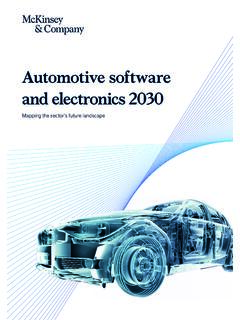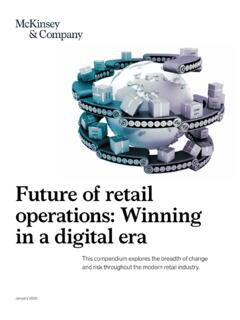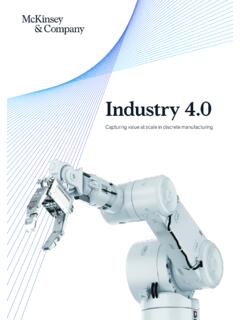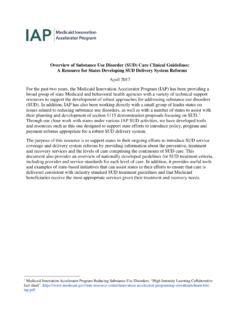Transcription of May 2011 Big data: The next frontier for innovation ...
1 McKinsey Global InstituteBig data: The next frontier for innovation , competition, and productivityMay 2011 The McKinsey Global Institute The McKinsey Global Institute (MGI), established in 1990, is McKinsey & Company s business and economics research arm. MGI s mission is to help leaders in the commercial, public, and social sectors develop a deeper understanding of the evolution of the global economy and to provide a fact base that contributes to decision making on critical management and policy research combines two disciplines: economics and often have limited access to the practical problems facing senior managers, while senior managers often lack the time and incentive to look beyond their own industry to the larger issues of the global economy. By integrating these perspectives, MGI is able to gain insights into the microeconomic underpinnings of the long-term macroeconomic trends affecting business strategy and policy making.
2 For nearly two decades, MGI has utilized this micro-to-macro approach in research covering more than 20 countries and 30 industry s current research agenda focuses on three broad areas: productivity, competitiveness, and growth; the evolution of global financial markets; and the economic impact of technology. Recent research has examined a program of reform to bolster growth and renewal in Europe and the United States through accelerated productivity growth; Africa s economic potential; debt and deleveraging and the end of cheap capital; the impact of multinational companies on the US economy; technology-enabled business trends; urbanization in India and China; and the competitiveness of sectors and industrial is led by three McKinsey & Company directors: Richard Dobbs, James Manyika, and Charles Roxburgh. Susan Lund serves as MGI s director of research. MGI project teams are led by a group of senior fellows and include consultants from McKinsey s offices around the world.
3 These teams draw on McKinsey s global network of industry and management experts and partners. In addition, MGI works with leading economists, including Nobel laureates, who act as advisers to MGI projects. The partners of McKinsey & Company fund MGI s research, which is not commissioned by any business, government, or other institution. Further information about MGI and copies of MGI s published reports can be found at McKinsey & Company 2011 James ManyikaMichael ChuiBrad BrownJacques Bughin Richard DobbsCharles RoxburghAngela Hung ByersMcKinsey Global InstituteMay 2011 Big data: The next frontier for innovation , competition, and productivityviBig data a growing torrentpieces of content shared on Facebook every month30 billionprojected growth in global data generated per year vs. 40%growth in global IT spending5%terabytes data collected by the US Library of Congress in April 2011235sectors in the United States have more data stored per company than the US Library of Congress15 out of 17 to buy a disk drive that can store all of the world s music$600mobile phones in use in 20105 billionviiBig data.
4 The next frontier for innovation , competition, and productivityMcKinsey Global InstituteBig data capturing its valuepotential increase in retailers operating margins possible with big data60%more deep analytical talent positions, and140,000 190,000 more data-savvy managers needed to take full advantage of big data in the United millionpotential annual value to US health care more than double the total annual health care spending in Spain$300 billion potential annual consumer surplus from using personal location data globally $600 billion potential annual value to Europe s public sector administration more than GDP of Greece 250 billionBig data: The next frontier for innovation , competition, and productivityMcKinsey Global Institute1 Executive summary Data have become a torrent flowing into every area of the global Companies churn out a burgeoning volume of transactional data, capturing trillions of bytes of information about their customers, suppliers, and operations.
5 Millions of networked sensors are being embedded in the physical world in devices such as mobile phones, smart energy meters, automobiles, and industrial machines that sense, create, and communicate data in the age of the Internet of Indeed, as companies and organizations go about their business and interact with individuals, they are generating a tremendous amount of digital exhaust data, , data that are created as a by-product of other activities. Social media sites, smartphones, and other consumer devices including PCs and laptops have allowed billions of individuals around the world to contribute to the amount of big data available. And the growing volume of multimedia content has played a major role in the exponential growth in the amount of big data (see Box 1, What do we mean by big data ? ). Each second of high-definition video, for example, generates more than 2,000 times as many bytes as required to store a single page of text.
6 In a digitized world, consumers going about their day communicating, browsing, buying, sharing, searching create their own enormous trails of 1. What do we mean by "big data"? Big data refers to datasets whose size is beyond the ability of typical database software tools to capture, store, manage, and analyze. This definition is intentionally subjective and incorporates a moving definition of how big a dataset needs to be in order to be considered big data , we don t define big data in terms of being larger than a certain number of terabytes (thousands of gigabytes). We assume that, as technology advances over time, the size of datasets that qualify as big data will also increase. Also note that the definition can vary by sector, depending on what kinds of software tools are commonly available and what sizes of datasets are common in a particular industry. With those caveats, big data in many sectors today will range from a few dozen terabytes to multiple petabytes (thousands of terabytes).
7 In itself, the sheer volume of data is a global phenomenon but what does it mean? Many citizens around the world regard this collection of information with deep suspicion, seeing the data flood as nothing more than an intrusion of their privacy. But there is strong evidence that big data can play a significant economic role to the benefit not only of private commerce but also of national economies and their citizens. Our research finds that data can create significant value for the world economy, enhancing the productivity and competitiveness of companies and the 1 See A special report on managing information: Data, data everywhere, The Economist, February 25, 2010; and special issue on Dealing with data, Science, February 11, Internet of Things refers to sensors and actuators embedded in physical objects, connected by networks to computers. See Michael Chui, Markus L ffler, and Roger Roberts, The Internet of Things, McKinsey Quarterly, March sector and creating substantial economic surplus for consumers.
8 For instance, if US health care could use big data creatively and effectively to drive efficiency and quality, we estimate that the potential value from data in the sector could be more than $300 billion in value every year, two-thirds of which would be in the form of reducing national health care expenditures by about 8 percent. In the private sector, we estimate, for example, that a retailer using big data to the full has the potential to increase its operating margin by more than 60 percent. In the developed economies of Europe, we estimate that government administration could save more than 100 billion ($149 billion) in operational efficiency improvements alone by using big data. This estimate does not include big data levers that could reduce fraud, errors, and tax gaps ( , the gap between potential and actual tax revenue). Digital data is now everywhere in every sector, in every economy, in every organization and user of digital technology.
9 While this topic might once have concerned only a few data geeks, big data is now relevant for leaders across every sector, and consumers of products and services stand to benefit from its application. The ability to store, aggregate, and combine data and then use the results to perform deep analyses has become ever more accessible as trends such as Moore s Law in computing, its equivalent in digital storage, and cloud computing continue to lower costs and other technology For less than $600, an individual can purchase a disk drive with the capacity to store all of the world s The means to extract insight from data are also markedly improving as software available to apply increasingly sophisticated techniques combines with growing computing horsepower. Further, the ability to generate, communicate, share, and access data has been revolutionized by the increasing number of people, devices, and sensors that are now connected by digital networks.
10 In 2010, more than 4 billion people, or 60 percent of the world s population, were using mobile phones, and about 12 percent of those people had smartphones, whose penetration is growing at more than 20 percent a year. More than 30 million networked sensor nodes are now present in the transportation, automotive, industrial, utilities, and retail sectors. The number of these sensors is increasing at a rate of more than 30 percent a are many ways that big data can be used to create value across sectors of the global economy. Indeed, our research suggests that we are on the cusp of a tremendous wave of innovation , productivity, and growth, as well as new modes of competition and value capture all driven by big data as consumers, companies, and economic sectors exploit its potential. But why should this be the case now? Haven t data always been part of the impact of information and communication technology? Yes, but our research suggests that the scale and scope of changes that big data are bringing about are at an inflection point, set to expand greatly, as a series of technology trends accelerate and converge.

















